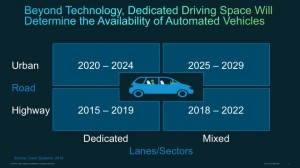
If cities would set aside dedicated lanes on highways or exclusively autonomous sectors in cities, autonomous vehicles could probably become reality as early as 2015 to 2019 on dedicated highway lanes and 2020-2024 in dedicated city sectors. Mixing with and managing the human errors of drivers in conventional vehicles will move the time horizon for fully autonomous vehicles out to 2018 to 2022 on mixed highway lanes and post 2025 in mixed urban driving sectors.
Today, technology is assisting drivers in preventing crashes (e.g., line keeping assist) and is allowing drivers to delegate driving to the “autopilot” under certain circumstances (e.g., adaptive cruise control). It is available in many premium models and also becoming an option in other vehicle categories for all who are willing to pay a premium for a safer ride. Cruise, a startup just announced plans to launch a $10,000 autonomous aftermarket kit for newer Audi cars early 2015. While the call is still out whether upgrading conventional vehicles to become autonomous is a viable strategy, it is a good example for how quickly the technology is evolving.
Technology companies and automakers have fully autonomous vehicles that have driven hundreds of thousands of miles on our roads to date. The time when we can buy and ride in a fully autonomous vehicle will not only depend on the autonomous vehicle technology the industry is maturing at rapid pace, but even more on the driving space we allow such vehicles to drive in. The options are best described in a four quadrant grid: One axis differentiates highway and city driving, the other axis distinguishes exclusive or non-exclusive driving space, meaning whether autonomous vehicles operate on dedicated lanes or city sectors or have to mix and cope with the mistakes of conventional drivers.
An investment in driverless vehicles will likely break even within one to six years, depending on the readiness of the auto insurance industry to adapt rates to the lower risks of autonomous vehicles and on owners’ willingness to share autonomous vehicles.
The fixed ownership cost of the average U.S. passenger vehicle is approximately $8,700 per year:
- $4,300 depreciation, financing
- $1,900 license, parking, warranty, etc.
- $1,500 crash related cost born by the owner
- $1,000 auto insurance
Human error accounts for over 90% of crashes. Assuming autonomous vehicles can eliminate 80% of this risk, the average vehicle owner would save approximately $1,800 (80% x 90% x $2,500) each year.
Conventional vehicles are used less than 5% of their usable time. The convenience of being able to call an autonomous vehicle when it is needed and easily release it for others to use when it is not needed is likely to make autonomous car sharing a much more convenient and cost-efficient mode of transportation for many. Assuming the remaining ownership cost ($6,900) can be shared by 3 users, this would equate to additional savings of $4,600 per user.
For the purpose of this “back of the envelope calculation”, let’s assume that structural design savings and the incremental autonomous cost are a wash. Virtually crash-less autonomous vehicles would require less structural and other safety features (e.g., fenders, airbags) built into vehicles, thus reducing cost and weight.
According to a recent Morgan Stanley study, driverless technology is estimated to initially add about $10,000 to the cost of a vehicle (less than the cost of a battery pack for an average electric vehicle). At the above savings rates, the investment in an autonomous vehicle would pay back in year six at $1,800 crash risk related savings, and in year two at $6,400 savings including the sharing option.
With mass market adoption, the autonomous upgrade cost is expected to go down to about $5,000 per vehicle. At this price point, the investment in an autonomous vehicle would pay back in year three at $1,800 crash risk related savings, and in less than a year at $6,400 savings including the sharing option.
Excellent article. I took a slightly different approach to the model and looked at what a Transportation as a Service approach might cost the end consumer. I start this article with a story about what life might be like in the year 2040.
http://viodi.com/2014/06/02/googles-potential-end-game-transport-and-organize-the-worlds-people-not-just-information/
In my model, I assume a subscription model and that the per capita cost for 90% of the people would be less than $300 per month.